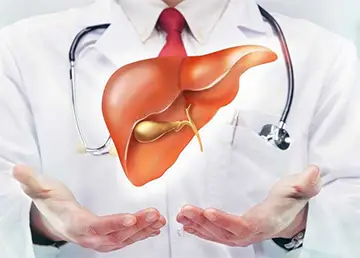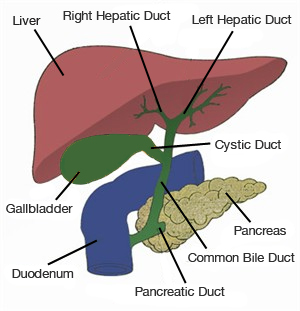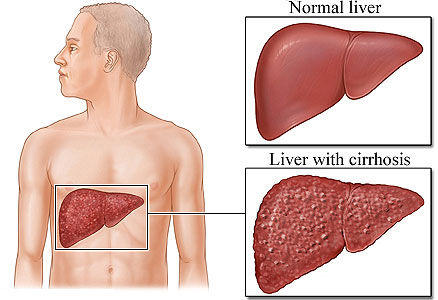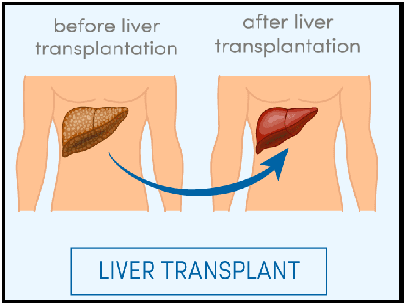Liver Transplantation
Liver Transplantation in Pune
Liver transplantation or hepatic transplantation is the replacement of a diseased liver with a healthy liver from another person. Liver transplantation is a treatment option for end-stage liver disease and acute liver failure, although the availability of donor organs is a major limitation. meet the best Dr. Sachin Palnitkar for Liver Transplantation in Pune.
Your liver is your largest internal organ and performs several critical functions, including:
* Removing bacteria and toxins from the blood
* Preventing infection and regulating immune responses
* Processing nutrients, medications and hormones
* Producing bile, which helps the body absorb fats, cholesterol and fat-soluble vitamins
* Making proteins that help the blood clot

Liver transplant is usually reserved as a treatment option for people who have significant complications due to end-stage chronic liver disease. In rare cases, sudden failure of a previously normal liver may occur. The number of people waiting for a liver transplant greatly exceeds the number of available deceased-donor livers.
The liver is a vital organ, meaning that one cannot live without it. The liver serves many critical functions including metabolism of drugs and toxins, removing degradation products of normal body metabolism (for example clearance of ammonia and bilirubin from the blood), and synthesis of many important proteins and enzymes (such as factors necessary for blood to clot).
Blood enters the liver from two channels, the hepatic artery and the portal vein, bringing nutrients and oxygen to liver cells, also known as hepatocytes, and bile ducts. Blood leaves the liver via the hepatic veins which drain into the inferior vena cava which immediately enters the heart. The liver makes bile, a liquid that helps dissolve fat and eliminate metabolic waste and toxins via the intestine. Each hepatocyte creates bile and excretes it into microscopic channels that join to form bile ducts. Like tributaries joining to form a river, the bile ducts join to form a single “hepatic duct” that brings bile into the intestine.
The human liver regenerates and returns to its normal size shortly after surgical removal of part of the organ. This makes living-donor liver transplant an alternative to waiting for a deceased-donor liver to become available.
In 2014, about 7,200 liver transplants were performed in the U.S. among both adults and children. Of those, about 330 involved livers from living donors. At the same time, nearly 15,000 people were registered on the waiting list for a liver transplant.
Liver transplantation in Pune is an operation that replaces a patient’s diseased liver with a whole or partial healthy liver from another person. This are explains the current indications for liver transplantation, types of donor livers, the operation itself, and the immunosuppression that is required after transplantation.

Who Needs a Liver transplant?
Liver transplantation surgically replaces a failing or diseased liver with one that is normal and healthy. At this time, transplantation is the only cure for liver insufficiency or liver failure because no device or machine reliably performs all of the functions of the liver. People who require liver transplants typically have one of the following conditions.
In children, a common reason for liver transplantation is biliary atresia in which the bile ducts that transport the bile from the liver to the gall bladder and help in digestion are under developed. In the initial few months of life a reconstructive surgery may be undertaken to correct this condition. However, some children go on to develop deep jaundice and finally liver failure.
A Liver Transplant Required for Patients Who Suffer from:
- Liver damage due to alcoholism (Alcoholic cirrhosis)
- Primary biliary cirrhosis
- Long-term (chronic) progressive virus (hepatitis B or C)
- Liver (hepatic) vein clot (thrombosis)Childbirth defects of the liver or bile ducts (biliary atresia)
- Metabolic disorders compared with liver failure (e.g., Wilson’s disease)


Life After Liver Transplant
Liver transplant recipients undergo an extraordinary life transformation after a successful operation. They get their lives back to the point they were before they ever got sick. They can realize their full potential in life with minimal medications and restrictions. Daily follow up with the Transplant Team ensures long term success and a healthy, happy, fulfilling life.
There are several new things a person experiences after liver transplantation. Before you leave the hospital, our team will provide all the instructions you and your family will need in caring for the “new” you.
Three months after the transplant, most patients have recovered completely, returned to work, and are enjoying active lives. our aim to give expert care and excellent follow-up, working with your primary care physician, to make the extent and quality of your life appreciably better than before. We urge you and your local doctor to keep in touch with the CLDT to let us a partner in your ongoing care.
Diet After Liver Transplants
Liver transplant beneficiaries should enjoy a regular healthy diet. Weight gain is not uncommon because the patient is feeling healthier and the steroid medicines increase appetite. Healthy diets (with no particular restrictions), portion control and regular exercise will protect against unhealthy weight gain.

Acute Liver Failure
Acute liver failure, also known as fulminant hepatic failure, occurs when a previously healthy liver suffers massive injury resulting in clinical signs and symptoms of liver insufficiency. Any number of things can lead to acute liver failure but the most common causes are acetaminophen (Tylenol®) overdose, viral infections (known or yet unknown virus), ingestion of a toxin such as poisonous mushrooms, or an idiosyncratic drug reaction.
The hallmark of this condition is the development of confusion (encephalopathy) within eight weeks after the onset of yellowing of the skin (jaundice). Confusion occurs because toxins typically metabolized by the liver accumulate. Unlike patients with chronic liver disease, who can survive weeks to months to years while awaiting liver transplantation, patients with acute liver failure may die within days if not transplanted. These patients are listed at highest priority (Status I), placing them at the top of local, regional and national waiting lists for a donor liver.
Chronic liver failure
The liver has a remarkable ability to repair itself in response to injury. Nevertheless, repeated injury and repair, typically over many years and even decades, scars the liver permanently. The end stage of scarring is termed cirrhosis and corresponds to the point where the liver can no longer repair itself. Once a person has cirrhosis, he or she may begin to show signs of inadequate liver function. This is termed “decompensated liver disease.” Although medications can decrease the symptoms caused by the liver failure, liver transplantation represents the only permanent cure.
Signs and Symptoms of Decompensated Liver Disease
Gastrointestinal bleeding: As the liver becomes increasingly scarred, the resistance to portal blood flow increases leading to increased pressure in the portal venous system. This portal hypertension necessitates alternative routes for blood to return to the heart.
Fluid retention : One function of the liver is to synthesize many of the proteins circulating in the bloodstream, including albumin. Albumin and other proteins in the bloodstream retain fluid in the vascular space by exerting what is known as an oncotic (or osmotic) pressure.
Encephalopathy: Failure of the liver to clear ammonia and other toxins from the blood allows these substances to accumulate. These toxins result in cognitive dysfunction that ranges from disturbed sleep-wake cycle patterns to mild confusion to coma.
Jaundice: One of the main functions of the liver is to eliminate the degradation products of hemoglobin, the molecule that carries oxygen in our blood. Bilirubin is one of those degradation products processed and excreted by the liver. In liver failure, bilirubin is not cleared from the body and bilirubin levels increase in the blood. The skin and all tissues of the body will then assume a yellow color.
What are the positive aspects of liver donation?
- The ability of an organ can save the life of a transplant candidate.
- Donors have reported positive emotional experiences, including feeling good about giving life to dying persons.
- Transplantations can greatly enhance recipients’ health and quality of life, allowing them to return to regular activities.
- Transplantation candidates usually have better results when they get organs from living donors as compared to organs from deceased donors.
- More suitable genetic matches between living donors and candidates may decrease the risk of organ rejection.
- A live donor makes it possible to schedule the transplantation at a time that is suitable both for the donor and the transplant candidate.
